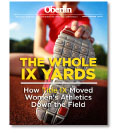title="Return to Table of Contents">Oberlin Alumni Magazine
Winter 2013 Vol. 108 No. 1
Obereactions
Revolution Number IX

Your article ("The Whole IX Yards," Fall 2012) hit home with me. From 1967 to 1971, the years I attended Oberlin, athletics for women meant cheerleading and synchronized swimming. Maybe there were other offerings for women, too, but certainly athletics for most students meant football, basketball, soccer — all for men.
Title IX has had an outsized impact on American life by granting women access to resources and programming previously reserved for men. It has also broadened the appeal of athletics and fitness to an even wider swath of American life. Even those who were never athletes are now exercising regularly and longer in life for health benefits and a personal sense of wellbeing.
Entry level athletics programs in local communities and high schools rival those offered in small colleges like Oberlin. Many of the bright students Oberlin wants to attract are also athletes. To draw these students, we need to look seriously at our financial commitment to teaching our students to adopt a healthy lifestyle. What we don't provide, other colleges will.
There are some bright spots. The track is state of the art and beautiful. The new indoor facility in the old hockey rink is also attractive and much needed.
But the college has failed to keep pace with comparable schools in updating its facilities. The Phillips complex predated the momentous changes in our view of what it means to be a healthy individual. Its locker rooms, pool, and fitness centers need updating to serve all Oberlin students, not just men. The field house, which once housed a good basketball program, had serious structural problems before it was torn down. The football stadium has crumbling concrete stairs and grass turf, which limits its use in bad weather. Not important, you say? Our local high school has five artificial turf fields used by both men and women in all sports, not just football.
This is not about promoting big time college athletics, which often distort (if not abuse) the educational mission. Our aim should always be to help our students be the best they can possibly be. If excellence is the college's goal in all things academic and musical, excellence should be its goal in fitness and athletics, too.
I applaud you for a long overdue article on an important issue for the college's future. I urge alumni to consider seriously the need for updating our athletic complex as part of the Illuminate campaign.
When I was assistant vice president for development/alumni in the late '70s, with the football team down to 16 players and another capital campaign underway, I was asked to develop a plan to raise money specifically to refresh football — coaches, equipment, facility upgrades, etc. I suggested we broaden the scope to also include coaches for the struggling women's athletic and varsity sports program and build more strongly, as Title IX was already more than five years "in play." Title IX took place in my senior year and was actually a component of the Jack Scott and Tommie Smith efforts that school year.
When I took on the assignment and sat down face-to-face with the leadership of the Downtown New York Athletic Club — the entity behind the Heisman Trophy, I shared with them our football needs (given Heisman's Yeomen efforts) and the ongoing "start-up" of women's varsity sports. They accepted and gave me permission to apply the Heisman name to our efforts (only such approval provided by the club), and Oberlin's John W. Heisman Club was quickly and firmly established.
Yes, today "every team has a head coach and an assistant and budgets — but it took a while." Had the Heisman Club just energized football, women's varsity sports would have taken many more years to truly get where it needed and deserved to be!
It appears this broader approach to athletics that we advocated continues. In the just-announced new campaign, there is major focus once again to improve health, wellness, varsity sports, intramurals, and club sports!
Go Yeo!
ETCHED MEMORIES
Paul Arnold left a legacy of love and generosity that touched hundreds, if not thousands, of lives ("Losses," Fall 2012). During the years I spent as a student in Oberlin's printmaking studio, the most relished moments occurred when Paul would invite me into his office for a chat. I vividly recall the books on his shelves; artwork on the walls; evidence of his work in progress; his favorite hat; and most distinctly, the faint smell of pipe tobacco. He was encouraging and questioning, epitomizing the core of a good liberal arts education. At the end of the day, he would get on his bike and ride home to his family to whom he was equally devoted. The down-to-earthiness with which he lived his life exudes from his woodcuts. His color block prints achieved simplicity of design and expressed the significance of being. Go gently then Paul. Continue the journey on your bike through a river of images and lived moments resonating with the spirit of love.
MORE CIVIL RIGHTS STORIES
Your article on alumni memories of the civil rights movement (Summer 2012) did a very impressive job of covering a huge amount of material. It is important to remember, however, that there were hundreds of thousands of people of African heritage who risked their jobs, their homes, and their lives to end the system of white supremacy in the Deep South, whose names are not recorded and who never receive the honor they so deeply deserve.
Oberlin Alumni Magazine welcomes comments from readers.
Please address your letters to:
Oberlin Alumni Magazine,
247 W. Lorain St., Suite C,
Oberlin, OH 44074-1089
Phone: 440.775.8182 or email alum.mag@oberlin.edu.
Letters may be edited for clarity and space.
